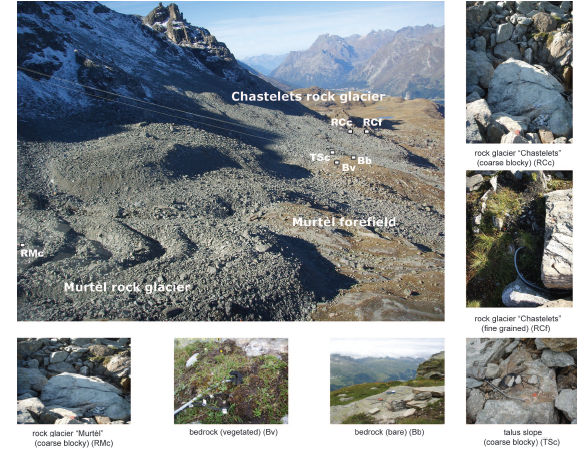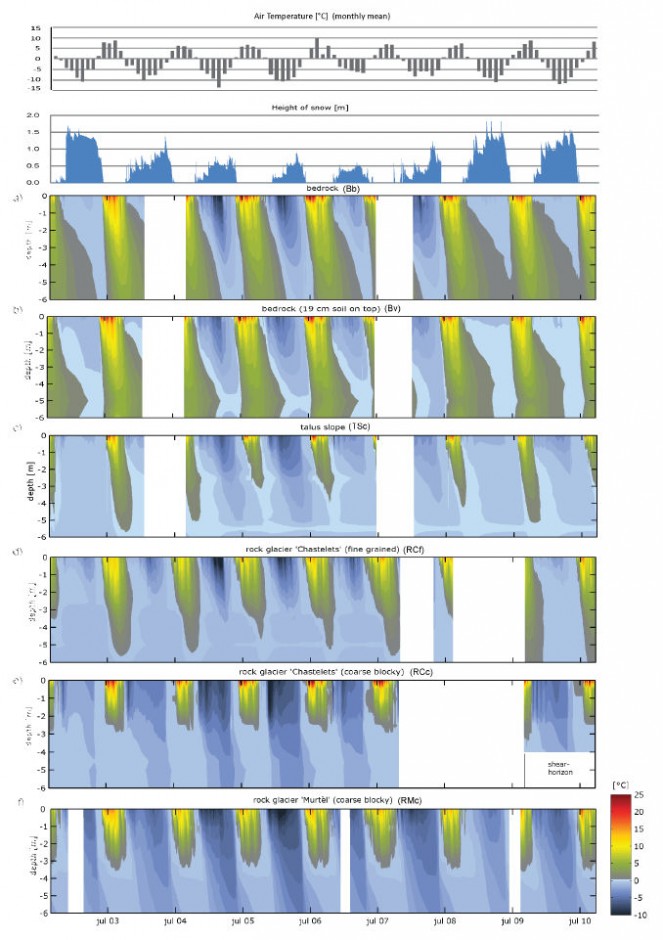In this month’s Geosciences Column, David Bressan – now a regular EGU contributor – highlights a recent result published in The Cryosphere with implications on the occurrence and preservation of alpine permafrost.
The last 150 years saw an increase of 0.8°C in the Earth’s mean global temperature. In mountain ranges like the European Alps, however, this rising trend is even more pronounced with an increase of 1.5°C in temperature observed over the same period. This rise not only accelerates the retreat of the alpine glaciers, but also causes the slow degradation of alpine permafrost – solid material with temperatures well below the freezing point of water at 0°C – and rock glaciers – lobes composed of a mixture of ice and rock debris, covered by a few meters of ice-free debris.
On a superficial glimpse, the permafrost seems relatively well isolated from superficial changes due to the cover of ice-free soil and rocks. However, measurements in the past few years have shown that the melting rate of ice inside the rock glaciers significantly increased in the last decades, which could lead to the destabilization of mountain slopes and could influence the hydrology of nearby springs.
To understand the behavior of permafrost in a warmer future it is therefore essential to understand how the material (for example different rock types) and the texture (like grain size or distribution) of the layers covering the permafrost transport heat from the warming surface into the frozen underground. Heat transfer in these layers can occur in two ways: conduction trough the rocky material or convection by mobile phases, like air or water, in the voids and pores of the material.
Scientists first investigated the site of the Murtel rock glacier, located in the mountains of the Swiss canton of Engadin, in 1970. The area has since become one of the best documented sites for mountain permafrost in the world. Permafrost occurs here below very heterogenous substrate like barren bedrock, vegetated bedrock, debris of a talus slope, fine-grained and coarse-grained debris of two rock glaciers. In a long-term project, geographer Sina Schneider and her team analyzed the temperature profiles of these different substrates, recorded in five boreholes over a period of eight years (2002–2010). The study was published last year in The Cryosphere, an open access journal of the European Geosciences Union.

Photographs of the different surfaces at the borehole locations in the investigation area, taken in summer 2009 (from Schneider et al. 2012).
The results confirmed in part previous observations, but showed also new intriguing finds. Freezing during late autumn and early winter influences significantly the temperature profile in all boreholes, as without an impermeable snow cover cold air can penetrate into the pores of the material. A dry winter with lacking or thin snow cover and rare freezing can therefore be more important for thawing permafrost than a hot summer.
Also the covering material can influence the behavior of the subsurface permafrost. Sites covered with an isolating cover of soil and vegetation showed significantly fewer fluctuations in the temperatures between winter and summer.

Borehole temperature data from 2002–2010 compared to monthly mean air temperature and snow cover. In bedrock the superficial heat (red and green colours) is conducted deep into the underground. Coarse-grained debris (like found at the talus slope or at the rock glaciers) is a relative effective insulator; however in fine-grained debris heat penetrates deep into the underground, causing thawing of permafrost (from Schneider et al. 2012).
In coarse-grained material air circulation in the voids plays a major role, cooling the underground effectively. Both in the coarse-grained debris of the talus slope and in the rock glacier no significant increase of temperatures along the contact between cover and permafrost was observed in eight years. However, it was in fine-grained material that most permafrost thawing occurred. Numerous complex processes, like water infiltration, freezing and air circulation, seem to be especially effective in the small pores of fine-grained sediments and transport heat deep into the underground.
In computer models used to calculate the changes and future distribution of permafrost and permafrost-related natural hazards the composition of the surface is often neglected – in part due the difficulties to gain detailed information in rugged mountain terrains. However the study by Schneider et al. shows that sediment type and size does matter and detailed field survey and data collection play essential parts in understanding the reactions of the hidden permafrost in a warmer climate.
By David Bressan, freelance geologist based in Italy
